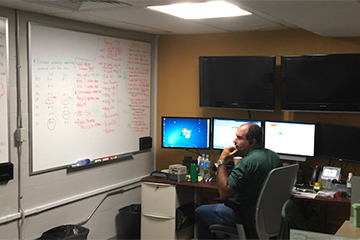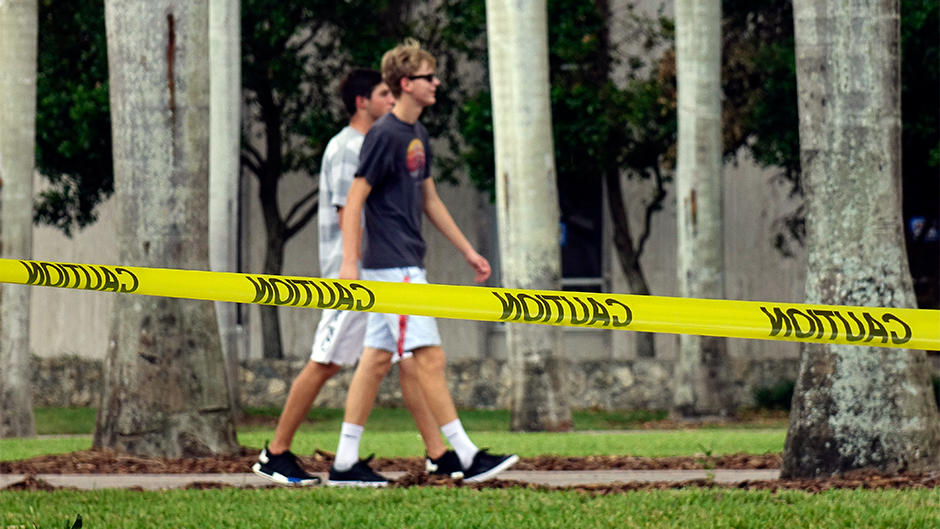Yellow ribbons are typically emblems of the ties that bind, of hope for the return of loved ones. But as classes resume on the Coral Gables campus Monday, the yellow ribbon takes on a quintessentially University of Miami meaning: one of resilience, recovery, and teamwork.
Tied to damaged trees and branches and marking debris piles and other hazards, strands of yellow caution tape are the most visible and, in many places the only, sign of the incomprehensible wreckage of toppled trees, downed power lines, and hidden damage to critical building management systems that the lashing by Hurricane Irma’s outer fringes left on Sunday, September 10.
The 260-acre grounds aren’t quite as lush as they were when, five days earlier, the University announced it would close, allowing its 31,000 students, faculty, and staff to prepare or evacuate for what forecasters predicted could be a direct hit from a monstrous Category 5 hurricane.
Yet today, more than 4 million pounds of landscape debris—more than the combined weight of the entire student body—has been chopped, chipped, and hauled away. Nearly every inch of grass is mowed, raked, and blown, and every parking lot, sidewalk, and courtyard swept of mountains of leaves. Two downed power line feeders from a University substation and 350,000 points on the energy and building management systems are up and running again, albeit some still manually, rather than automatically and remotely, controlled. The Hecht-Stanford Dining Hall immediately resumed operations—to serve the recovery workforce and a few dozen students who, unable to evacuate, were sheltered nearby.
The remarkable recovery is a testament to both advance preparation and planning and the dedication and teamwork of more than 300 University personnel, vendors, and contractors who put the U’s needs before their own. They and countless others worked under immense pressure to accomplish a post-Irma directive that was as daunting as it was simple: make the campus look like nothing had happened.
Jacqueline A. Travisano, UM’s new executive vice president for business and finance and chief operating officer, momentarily thought that would be impossible when she first saw the campus in shambles the Monday after Irma’s passage.
“It was heartbreaking,” said Travisano, who also oversees Facilities and Real Estate, the UM Police Department, and Office of Emergency Management. “All I saw was devastation, but the grief lasted for about five seconds because we had a lot of work to do, and we planned for and were prepared to do it. During the actual emergency, there was no anxiety except where the hurricane was going to hit. Everything was preset.”
What wasn’t preset was imbued with the indomitable spirit of ’Canes helping ’Canes. Even before the University’s contracted cleanup crews arrived, alumnus Jose I. Bared was knocking on the McKnight Building, where the University’s Emergency Operations Center (EOC) had relocated. The son of UM Trustee Jose P. Bared, Bared and his business partner and fellow alumnus, William Real, wanted to know how they could help.
By that afternoon, their general contracting company, Civic Construction, had deployed a backhoe, bobcat, and dump truck. By the next day, 12 Civic Construction dump trucks, 12 bobcats, and six backhoes were on the grounds—all under the supervision of Bared’s son, a college senior, and Real’s son, a high school junior.
“I’ve got to tell you it was a pleasure working with the UM staff,’’ Bared said. “I can’t say it was easy—nothing was easy—but nothing would have happened without UM’s incredible support, organization, and encouragement. We’ve worked with a lot of cities, and UM is by far ahead of everybody on how quickly they were able to react and make decisions.”
Making Civic Construction’s work and that of the other crews that followed possible were 75 employees from Chartwells, UM’s food service provider, who nourished the bodies and souls of the recovery teams. They prepared three meals a day in the air-conditioned refuge of Hecht-Stanford Dining Hall, even dispatching Parking and Transportation personnel to deliver pallets of Powerade and boxes of bananas to crews in the field.
“Our jobs were easy compared to the folks working in 95-degree heat,” said Chartwells director Michael Ross, who had ensured all perishables were moved to walk-in coolers that would switch to generator power when the electricity went out. “It was a team effort—with facilities, parking, human resources, auxiliary services, the police department—-and it was a pleasure to serve them. We’re part of the community and that’s what we do.”
Others put themselves at peril ensuring critical services never faltered. At University of Miami Hospital, which during the storm hosted roughly 1,400 patients, staff, and their families, including 68 pets, a main elevator bank failed three times—with Irma’s winds howling outside. It fell to Rolando Rivero, director of plant operations, to climb 14 flights of stairs to the roof and an open 10-foot staircase to reach the motor room and reset the elevators.
“He was very brave, but our elevators had to remain working,” said Michael Gittelman, UMH’s CEO.
 |
| Eli Stephan |
Back on the Gables campus, Eli Stephan, senior manager for facilities, management and operations, took on the task of keeping the overburdened generator at the EOC’s original Flipse Building location fueled through the storm. Throughout the long night, he ventured outside to scavenge and haul 80 gallons of fuel to keep it running.
Come daylight, Stephan was the first to assess the bewildering tangle of vegetation and other debris that crippled the campus. But he had no time for emotion. He knew that, until the roads were passable and the 125 buildings on campus were accessible, the hidden damage to the infrastructure systems that keep buildings comfortable and safe could not begin. He would spend six days overseeing the massive effort to clear 2,000 tons of debris from the campus.
“My first thought,” said his colleague, Jose Varona, the director of building and energy management systems, “was this is going to take a long time. But we had a detailed plan on how to clear the roads, inspect and access the buildings, find the parts we need, and get our students back as quickly as possible.”
Over the coming days, Varona and his team of energy, and heating, ventilation, and air-conditioning technicians will continue restoring all automated building systems.
 |
| Jose Varona |
And like most Floridians, they know how lucky Southeast Florida and UM were. Even though a rooftop anemometer at the Miller School of Medicine recorded a wind gust of 127 miles per hour, and the waterfront Rosenstiel School of Marine and Atmospheric Science on Virginia Key endured a 3-foot storm surge, both resumed normal operations last week. And Monday, as classes resume, yellow caution tape is the most prevalent sign of Irma’s assault on the Coral Gables campus.

